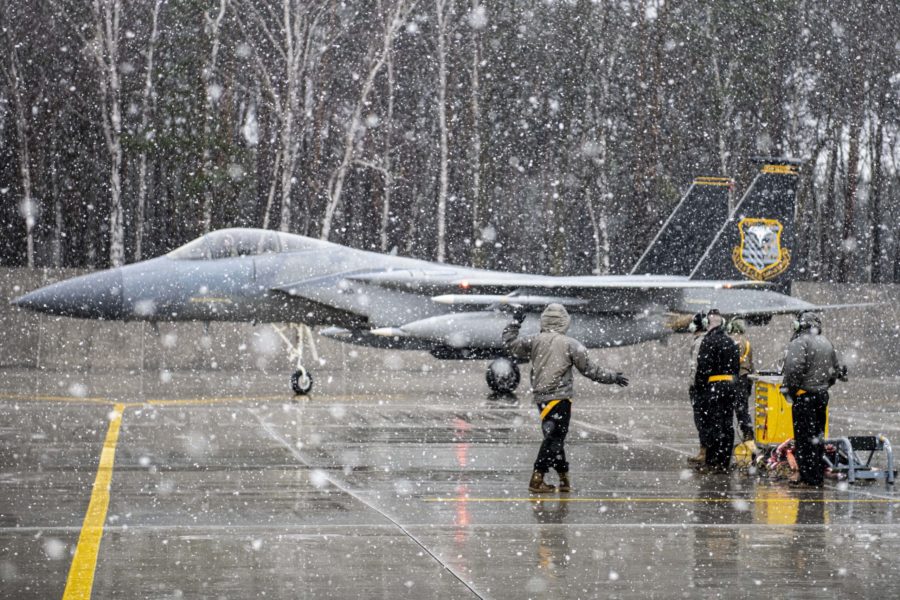The U.S. Air Force sent F-35 fighters to Germany days after a B-52 Bomber Task Force arrived in England to reassure Allies amid increasing tensions in Eastern Europe. The deployments come as defense ministers from across the NATO alliance decided Feb. 16 to further strengthen deterrence and defense in response to Russia’s aggression on the Ukraine border.
The F-35s deployed from the 34th Fighter Squadron, 388th Fighter Wing, at Hill Air Force Base, Utah, to Spangdahlem Air Base, Germany, on Feb. 16 to enhance NATO’s defense posture, according to U.S. Air Forces in Europe.
“This deployment is being conducted in full coordination with the German government and NATO military authorities, and although temporary in nature, it is a prudent measure to increase readiness and enhance NATO’s collective defense during this period of uncertainty,” USAFE spokesperson Capt. Erik Anthony said in a statement.
B-52s from the 5th Bomb Wing at Minot Air Force Base, N.D., also arrived at RAF Fairford, U.K., on Feb. 10 for a “long-planned Bomber Task Force mission,” according to a USAF release. Eight additional F-15s from the 336th Fighter Squadron, 4th Fighter Wing, at Seymour Johnson Air Force Base, N.C., deployed to Lask Air Base, Poland, on Feb. 14 to augment the eight F-15s already there from the 48th Fighter Wing at RAF Lakenheath, U.K., U.S. Air Forces in Europe previously confirmed to Air Force Magazine. Eight F-16s from the 52nd Fighter Wing at Spangdahlem also deployed to Fetesti Air Base, Romania, on Feb. 11. The fighter jets in both locations will take part in NATO enhanced air policing missions and joint training.
“With an ever-changing global security environment, it’s critical that our efforts with our allies and partners are unified,” USAFE commander Gen. Jeffrey L. Harrigian said in the release. “We’re in Europe training and collaborating together, because consistent integration is how we strengthen our collective airpower.”
The aircraft movements are in addition to deploying 3,000 Soldiers from the Army’s 82nd Airborne Division to Poland and 1,000 from a U.S. Stryker squadron at Vilseck, Germany, to Romania. Another 8,500 U.S. troops are on high alert in the United States to act as a NATO Response Force, if called upon.
‘Dangerous Moment’
During the NATO meeting, defense ministers said Russian claims that troop and equipment withdraws have begun from Crimea have yet to be confirmed. At the White House a day earlier, President Joe Biden warned Americans of higher fuel prices and said, “An invasion remains distinctly possible.”
In his first public comments dedicated to the crisis in Ukraine on Feb. 15, Biden told Americans he welcomed diplomatic overtures by Moscow but required proof of de-escalation.
“We have not yet verified that Russian military units are returning to their home bases,” he said of the estimated 150,000 Russian troops surrounding Ukraine on three sides. “Indeed, our analysts indicate that they remain very much in a threatening position.
“If Russia does invade in the days or weeks ahead, the human cost for Ukraine will be immense, and the strategic cost for Russia will also be immense,” the President added.
Biden promised “powerful sanctions” should Russia further invade Ukraine, and he said the Nord Stream 2 pipeline that would deliver gas between Russia and Germany would not be completed, although his German counterpart has not been as committal.
The regular winter meeting of the alliance’s 30 defense ministers has been transformed into a Russia-Ukraine crisis counsel, with Secretary-General Jens Stoltenberg setting a somber tone on Day 1.
“We face a dangerous moment for European security,” declared Stoltenberg. “NATO is not a threat to Russia. And we remain ready to engage in dialogue and find a diplomatic way forward.”
However, by day’s end, defense ministers opted to further strengthen the eastern flank against potential Russian aggression with new battle groups that would be positioned in central and eastern, south-eastern Europe. France has already offered to lead one such battlegroup in Romania. Stoltenberg said the Alliance would report back on details “within weeks.”
In the past, pro-Russia alliance members Hungary and Turkey have opposed such moves, but an eastern flank NATO official told Air Force Magazine the decision “is more under what modalities and when.”
Likewise, when asked after the conclusion of the first day of meetings if NATO members believed that Russia was really withdrawing its forces, the official said, “not really.”
NATO alliance members have shown unity in promising tough sanctions; but have been less committal to provide defensive assistance to Ukraine in an effort to deter Russia.
The United States has sent $200 million worth of recently authorized defense assistance in 17 aircraft, including 180 tons of ammunition, anti-take javelins, and shoulder-fired grenades. Likewise, air defense Stingers from Lithuania arrived to Ukraine Feb. 13 and Ukrainian Defense Minister Oleksii Reznikov on Twitter thanked Canada for committing lethal weapons and ammunition.
In brief pre-ministerial comments alongside Stoltenberg, Defense Secretary Lloyd J. Austin III underscored the U.S. commitment to the NATO alliance.
“This is a very challenging time,” he said. “We are committed to Article 5, and also the principles of collective security. You can expect that that commitment will remain rock-solid going forward.”

